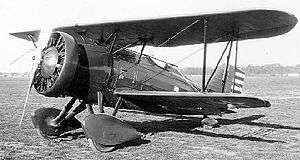Curtiss YP-20
| Curtiss YP-20 | |
|---|---|
 | |
| Parked YP-20 | |
| Role | Biplane fighter |
| Manufacturer | Curtiss Aeroplane and Motor Company |
| Primary user | United States Army Air Service |
| Number built | 1 |
|
| |
Curtiss YP-20 was a United States Army Air Service biplane fighter project developed by Curtiss.
In 1929, three Curtiss P-11 Hawks were ordered with 600 hp (447 kW) Curtiss H-1640 Chieftain engines. These proved a failure, and before completion, the third was converted to use a 9-cylinder 575 hp (429 kW) Wright Cyclone, being completed as the YP-20. Testing with the R1820 was prolonged, so the Army's intention to promptly switch to a Curtiss V-1570 Conqueror engine and redesignate the aircraft XP-22 was dropped; another P-11 was chosen for that instead.
Except for the engine change and its Townend ring cowling, the YP-20 was not drastically different from the P-6 from which both it and the P-11 derived, though the YP-20 had more fin and less rudder area,[1] and featured a steerable tailwheel, rather than the original skid.[2] Later, a crankcase cover, gear strut fairings, and wheel pants were added.
In June 1931, the AAC held a competition to evaluate the P-6, P-12, XP-22, and YP-20. The XP-22 came out the winner, but the YP-20 was given a nose and landing gear graft from the XP-22, becoming the XP-6E (P-6E prototype). With the addition of a supercharger and an enclosed cockpit, it was tested as the XP-6F.
Operators
Specifications (original YP-20)
Data from U.S.Fighters, Lloyd Jones, Aero Publishers 1975.
General characteristics
- Crew: one pilot
- Length: 23 ft 9 in ()
- Wingspan: 31 ft 6 in (9.6 m)
- Height: 8 ft 10 in (2.69 m)
- Wing area: 252 ft² (23.41 m²)
- Empty weight: 2,447 lb (1,110 kg)
- Max. takeoff weight: 3,233 lb ()
- Powerplant: 1 × R-1820 Cyclone air-cooled 9-cylinder radial engine, 575 hp (429 kW)
Performance
- Maximum speed: 215 mph (187 kn, 346 km/h)
- Range: 285 mi (248 nmi, 459 km)
- Service ceiling: 24,700 ft (7,529 m)
Armament
2 × 0.30 in (7.62 mm) M1919 Browning machine guns (cowl)
Notes
References
- Fitzsimons, Bernard, ed. Illustrated Encyclopedia of Weapons and Warfare. Volume 12, pp. 1255–6, "Hawk, Curtiss Models 34 and 35 (P-1 to P-6 and F6C". London: Phoebus Publishing, 1978.
- Donald, David, ed. Encyclopedia of World Aircraft. Etobicoke, ON: Prospero Books, 1997.
- Jones, Lloyd S. U.S. Fighters. Fallbrook, CA: Aero Publishers, 1975.